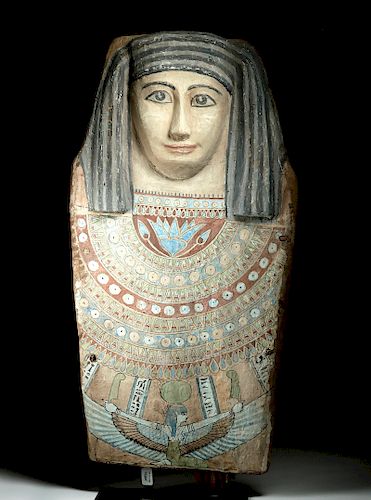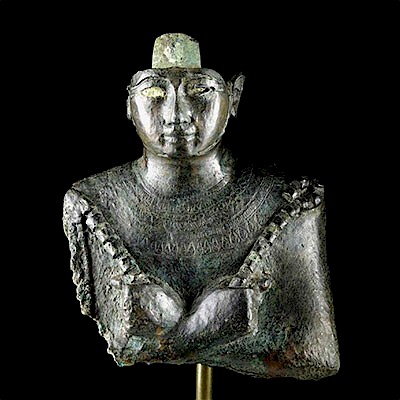Egyptian Late Period Polychrome Wood Sarcophagus Panel
Lot 6
About Seller
Artemis Fine Arts
686 S Taylor Ave, Ste 106
Louisville, CO 80027
United States
Selling antiquities, ancient and ethnographic art online since 1993, Artemis Gallery specializes in Classical Antiquities (Egyptian, Greek, Roman, Near Eastern), Asian, Pre-Columbian, African / Tribal / Oceanographic art. Our extensive inventory includes pottery, stone, metal, wood, glass and textil...Read more
Estimate:
$18,000 - $30,000
Absentee vs Live bid
Two ways to bid:
- Leave a max absentee bid and the platform will bid on your behalf up to your maximum bid during the live auction.
- Bid live during the auction and your bids will be submitted real-time to the auctioneer.
Bid Increments
| Price | Bid Increment |
|---|---|
| $0 | $25 |
| $300 | $50 |
| $1,000 | $100 |
| $2,000 | $250 |
| $5,000 | $500 |
| $10,000 | $1,000 |
| $20,000 | $2,500 |
| $50,000 | $5,000 |
| $100,000 | $10,000 |
| $200,000 | $20,000 |
About Auction
By Artemis Fine Arts
May 22, 2019
Set Reminder
2019-05-22 10:00:00
2019-05-22 10:00:00
America/New_York
Bidsquare
Bidsquare : Exceptional Day 1: Antiquities Asian Fine Art
https://www.bidsquare.com/auctions/artemis-gallery/exceptional-day-1-antiquities-asian-fine-art-4129
Day 1 of an important 2-day auction featuring exceptional art from around the world - Egyptian, Greek, Etruscan, Roman, Viking, Russian, Near Eastern; Asian Art from China, Japan, Thailand, Vietnam, Burma, India; Fine Art from the 17th century to present. Artemis Fine Arts info@artemisgallery.com
Day 1 of an important 2-day auction featuring exceptional art from around the world - Egyptian, Greek, Etruscan, Roman, Viking, Russian, Near Eastern; Asian Art from China, Japan, Thailand, Vietnam, Burma, India; Fine Art from the 17th century to present. Artemis Fine Arts info@artemisgallery.com
- Lot Description
Egypt, Late Period, 26th to 30th Dynasties, ca. 672 to 343 BCE. A striking Egyptian polychrome wood bust from an anthropoid sarcophagus of a woman, presenting an intoxicating visage that is at once remarkably human yet theatrical, with a head that is characteristically oversized relative to the body and bold features including very large, dramatically lined open eyes gazing steadfastly ahead framed by elegant brows that lead to a straight nose and gently smiling lips above a rounded chin, with a creamy white complexion, framed by a long tripartite black and blue striped wig. Adorning the chest is an elaborate polychrome collar with lotus flower and Isis iconography as well as beautiful 'beaded' strands, all delineated in cornflower blue, mint green, russet red, and creamy beige hues, the details of which are very well preserved. Size: 18.5" W x 37.25" H (47 cm x 94.6 cm); 39.25" H (99.7 cm) on included custom stand.
The beautiful collar features a blue lotus flower with budded tendrils in blue and red over a red ground at the top - and the goddess Isis sitting upon her knees while spreading her wings and donning her characteristic sun disk flanked by hieroglyphic panels is at the lower end. Between these iconographic highlights are many splendiferous rows of special beads of various shapes and vibrant hues.
Egyptians cultivated lotuses in the marshy land around the Nile, and it was believed that the flower gave them power and strength, perhaps relating to the use of a stylized lotus as a capital motif at the top of columns. Lotuses were also used as funerary adornments - for example, remains of the flower have been found in the tomb of Ramesses II - and as temple offerings and garlands worn by women during rituals.
The goddess Isis' story is central to the resurrection of the god Osiris - who in turn was central to the written and painted symbols of resurrection of the dead that formed such a crucial part of Egyptian cosmology.
These painted sections are made of gesso (a mixture of chalk, pigment, and gypsum) over wide linen strips over wood; a surface like this made for a more stable surface for painting. All in all, the painted iconography on this sarcophagus panel makes for a wondrous example of traditional Egyptian funerary art.
Ancient Egyptians believed it was of the utmost importance to preserve a body of the deceased, because the soul needed a place to reside after the death. Preservation of the body was done via mummification - a process involving the removal of internal organs that were placed in canopic jars, wrapping body in linen, and then embalming. Death masks and sarcophagus panels like this example were created so that the soul could recognize the body and return to it.
Cf. a full anthropoid sarcophagus from Akhmim, now in the British Museum, illustrated in J. H. Taylor, "Egyptian Coffins" (Aylesbury 1989), fig. 51, p. 62.
Provenance: private East Coast, USA collection; ex-private German collection, acquired in 1980; ex-Norman Bankman collection, New York, USA, acquired in 1950s; purportedly authenticated by Dr. Manfred Weber of Cologne University
All items legal to buy/sell under U.S. Statute covering cultural patrimony Code 2600, CHAPTER 14, and are guaranteed to be as described or your money back.
A Certificate of Authenticity will accompany all winning bids.
We ship worldwide and handle all shipping in-house for your convenience.
#145060Substantial areas of gesso and polychrome are well preserved. Normal wear with some losses to peripheries and gessoed passages commensurate with age. Verso was comprised of two panels - the separation between them was stabilized at one point. Nice remains of dowels used to secure to coffin.Condition
- Shipping Info
-
All shipping is handled in-house for your convenience. Your invoice from Artemis Gallery will include shipping calculation instructions. If in doubt, please inquire BEFORE bidding for estimated shipping costs for individual items.
-
- Buyer's Premium



 EUR
EUR CAD
CAD AUD
AUD GBP
GBP MXN
MXN HKD
HKD CNY
CNY MYR
MYR SEK
SEK SGD
SGD CHF
CHF THB
THB















